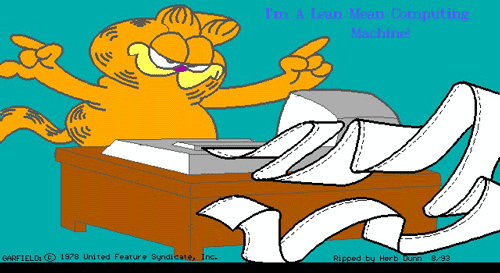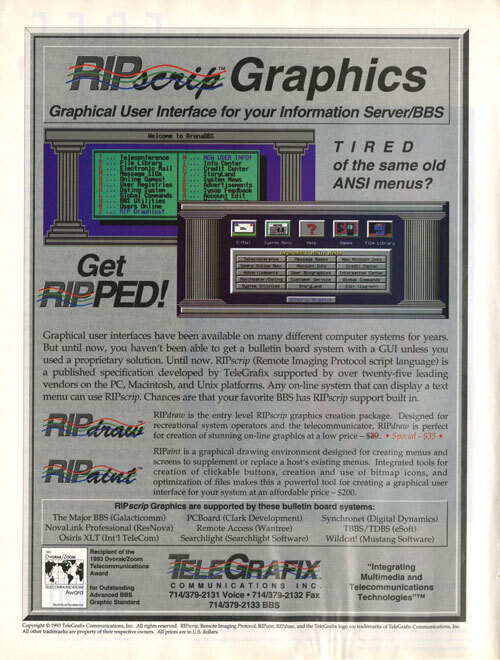
An example of a RIP-drawn graphic, featuring Garfield the cat, who hates dot-matrix printers but loves lasagna. (via Archive Team)
How RIP graphics became the de facto standard for nice graphics over a BBS
The above solutions were but for those of you that remember BBSes getting graphical in ways that looked slightly better than ANSI art, you most likely remember RIPscrip, which became the de facto standard for BBS-based graphics during the mid-1990s.
RIPscrip, developed by TeleGrafix, a company launched by a group of alumni from the computer manufacturer AST Research, eschewed both standardization and extending ANSI escape codes to come up with something that could be programmed by hand but could also be used to develop colorful GUI-style interfaces. As noted in a protocol specification gathered by the Internet Archive’s Jason Scott for his BBS: The Documentary, the language necessarily prized compression over source-code readability:
Earlier graphical script languages (Avatar and Skypix among others) utilize special command characters to indicate which graphics command is to be executed. This precludes their use on systems that are limited to ASCII printable text. Traditional script languages use English words to accomplish things (eg, “BOX 0,0 100,50”). This kind of thing is incredibly bulky, especially when you consider that pictures are usually not simple things, but [composed] of hundreds or thousands of individual graphical operations (eg, line, circles, fills, text, etc.). With this in mind, a human-readable script language was completely inappropriate for the relatively limited bandwidth of conventional modems.
So, one of our main strategies for this language was to make it as efficient as possible without going completely binary. This allows the immediate installation of the protocol onto any ASCII text-based host system—because the language consists entirely of ASCII-printable characters. We justify the unreadability of the language by pointing out the limitations of today’s modems and phone lines—the language must be compact.
RIPscrip, which probably saw its most prominent use in the early 1990s, was intended as an alternative to proprietary graphical solutions to online access such as CompuServe, America Online, and the aforementioned Prodigy, noted Jim Bergman, the vice president of TeleGrafix.
“We started the design of RIPscrip because we saw the many companies were doing on-line graphics, but they were requiring that you used their host and their terminal; in other words, a dedicated proprietary solution,” Bergman told The Computer Paper in 1993. “Also, as sysops, we’d often wished for some sort of graphical user interface for our boards. We’d come across many solutions, but they all fell short in one way or another. In short, we became frustrated.”
RIPscrip, like prior graphical scripting languages such as NAPLPS, serves a role very similar to what the SVG vector graphics format does today, but its major difference is that it could be used to build graphical user interfaces. (TeleGrafix was quick to note, though, that RIPscrip wasn’t, on its own, a GUI: “RIPscrip’s fundamental design and philosophy is geared toward allowing you, the service provider, the ability to display information in any manner that you want. This is simply not possible in most traditional GUI environments.”)

An early ad for RIPscrip that ran in an issue of Boardwatch Magazine in 1994. (Internet Archive)
This was an incredibly novel concept for its time—TeleGrafix, without labeling it as such, was selling BBSes AOL in a box, complete with the flexibility that AOL had at the time. That said, its definition of “open” differed in some important ways from what NAPLPS, for example, represented. While NAPLPS was a documented standard that had been used previously for television, RIPscrip was largely developed by a single company that sold the software both to BBS operators and the public. While RIP graphics could be developed without TeleGrafix’s help, they still ran the show.
Nonetheless, it didn’t scare off BBS operators, who saw the better graphics as an optional value-add for users. In a 1993 PC Magazine column, John C. Dvorak called RIPscrip’s ability to replicate GUI interfaces “phenomenal.”
“If you’ve been using a bulletin board over the past year, you’re already familiar with RIPscrip—the most quickly adopted standard I’ve ever seen in this industry,” he wrote.
Part of what might have impressed him: RIPscrip works with a mouse, a huge advantage compared to many BBS platforms of the time, which were straight keyboard affairs. But there were knocks against it: For example, RIP had a somewhat outdated look by the time it came to market around 1993 or so. Initially, it mostly adhered to the 16-color EGA specification; at the time, most PCs could support VGA or even Super VGA, which could display more colors at a time.
Eventually, RIPscrip would gain more capabilities. But, like so many other tools of the era, its best features simply did not translate very well to the modern internet.